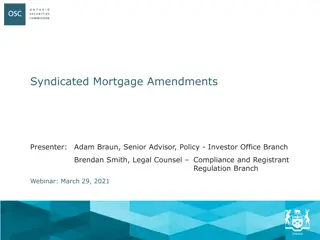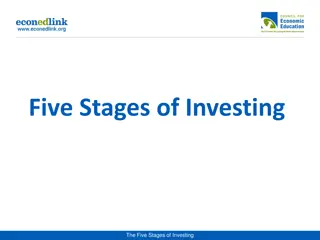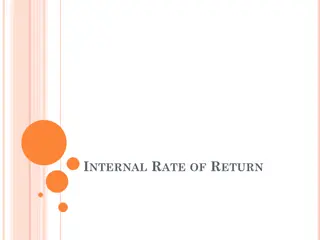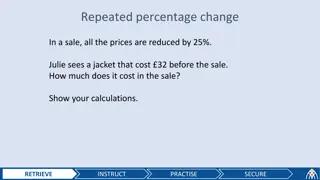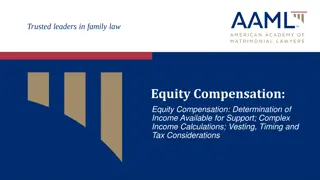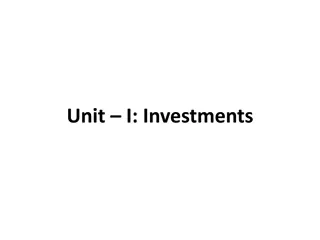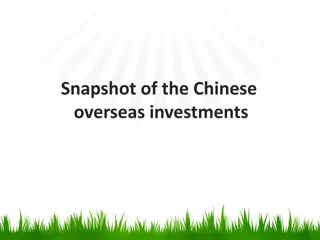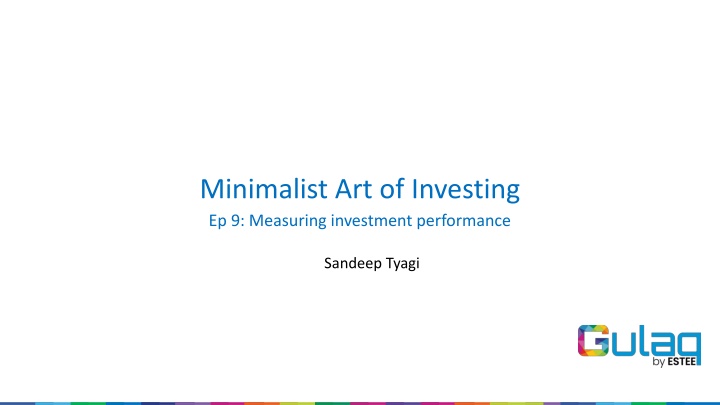
Measuring Investment Performance and Creating Savings Pools
Learn about measuring investment performance and creating savings pools for financial goals, including insights on separate vs. common savings pools, benefits, challenges, and recommendations. Explore investment planning for major goals like retirement, home buying, and children's education, understanding gear-based investing, active vs. passive investing, and avoiding noise in investment decisions. Get expert advice from Sandeep Tyagi and valuable resources from Gulaq for successful financial planning.
Download Presentation

Please find below an Image/Link to download the presentation.
The content on the website is provided AS IS for your information and personal use only. It may not be sold, licensed, or shared on other websites without obtaining consent from the author. If you encounter any issues during the download, it is possible that the publisher has removed the file from their server.
You are allowed to download the files provided on this website for personal or commercial use, subject to the condition that they are used lawfully. All files are the property of their respective owners.
The content on the website is provided AS IS for your information and personal use only. It may not be sold, licensed, or shared on other websites without obtaining consent from the author.
E N D
Presentation Transcript
Minimalist Art of Investing Ep 9: Measuring investment performance Sandeep Tyagi
Recap: First 8 Episodes Difficult to predict 1-year returns, easier to predict over long periods 10 Year Rolling returns (CAGR): Sensex 11.2%, FD 8.2%, 60-40 model portfolio 10.76% Savings rate of 25 to 40% is healthy Investment Planning for 3 big goals (Templates provided on Gulaq.com): Retirement Planning Buying a home Children s education Gear based investing: Take risk survey and find out your risk appetite Get any gear by mixing only two ingredients: Equity and Fixed income Active vs Passive investing: Figure out what kind of investor you are Avoiding Noise in investing and stay disciplined
OFFER FOR FREE CONSULTATION Follow us on social me dia Tag us Make a re que st F O LLO W U S O N Sandeep Tyagi GULAQ LinkedIn: https://www.linkedin.com/in/styagi/ LinkedIn: https://www.linkedin.com/in/gulaqnew Twitter: https://twitter.com/styagi Twitter: https://twitter.com/gulaqfintech Instagram: https://www.instagram.com/gulaqfintech/
Creating savings pool for 3 goals Chanchal Kumar is recently married and got 2 kids. He has 3 big financial goals and is exploring how to plan properly. Buy a home in 3 years Pay for kids foreign education Save for retirement He started investing in an index fund for Retirement, in FD for buying home. He is exploring some safe option for kids education goal. Should he save separately for each goal?
Separate savings pool : Benefits Majority saves separately for different goals. Some advisors even follow separate asset allocation within each goal. There are some benefits with having separate pool of savings: A sense of clarity on each goal Each pool of savings represents efforts on each goal Emotional attachment with every goal
Separate savings pool: Challenges When we compare the downside compared to benefits, the former outweighs the later. Inefficient asset allocation across goals Requirement of higher savings Challenge of managing & tracking multiple goals Plan for contingency for every goal Higher efforts required when deciding the split between goals out of lumpsum amount
Separate vs Common: Recommendation We did a case study on separate vs common savings pool for 3 goals shown earlier. Goal Time Target Money Monthly savings Monthly savings (common pool) Buy Home 3 years 10,00,000 24,669 - Kids Education 10 years 1,00,00,000 54,660 - Retirement 30 years 4,00,00,000 26,839 - Total - - 106,169 91,369 We recommend having a common savings pool for different goals
Measuring Performance I made profits I incurred loss Most people look at only returns while assessing performance. Do you know how to measure investment performance?
Risk vs Return Risk and Return are two sides of the same coin. There is no return without taking some risk. Fund A: Fund B: 12% returns last year 10% returns last year Which fund would you prefer to invest? Looking at only returns means looking at only physical beauty or income of your prospective spouse. Beauty or income is important, but there a lot other important traits which are to be considered. Similarly, in investment, risk as well as return are important.
Risk: Max Draw Down & Standard Deviation Risk is understood in two ways: Max Draw Down of investment and Standard Deviation of the returns Max Draw Down: Represents the maximum money one could lose if invested in a security. Measured by looking at the historical returns of the security. Standard Deviation: Variation of investment returns in the given period.
Risk: Information Ratio Information Ratio measures signal to noise ratio in investment. Signal is the average return and noise is the standard deviation of that return time-series. Year Fund A Fund B Year 1 10.2% 18.7% In Last 5 years, Fund A has 8.1% and Fund B has Year 2 6.0% 6.1% 12.2% average returns. Which fund is better? Year 3 5.8% 5.4% Year 4 6.7% 8.0% Investors use Returns over Risk to compare Year 5 11.6% 22.9% attractiveness of funds. The information ratio of Average 8.1% 12.2% Fund A is twice as good as Fund B. Standard Deviation 2.4% 7.2% Information Ratio 3.4 1.7
Separating Skill and Luck Profit or Loss is a combination of skill of the investor and underlying risk of the investment. Its almost impossible to make losses in fixed deposits and also to stay profitable every year in stock markets. -48.7% Loss in Warren Buffet portfolio in 1973 Ever questioned Warren Buffet s greatness in investing? 10 Years Loss making years in Warren Buffet career Secret to measuring performance: Separate skill and luck in investing. This is done by Using a proper benchmark for the investment
Separating Skill and Luck Warren Buffet invests mostly in US companies. A proper benchmark in this case would be S&P 500 index. Over 1965 to 2021, Warren produced 20.1% CAGR compared to S&P 500 s 10.5% CAGR Outperformance by 100% shows skill of the investor If its fixed deposit, compare with index of fixed deposit returns. Based on the portfolio asset allocation, an appropriate benchmark has to be tracked to measure the performance.
Power of compounding Years Invested 10 20 30 40 The skill of an investor in making a few percentage points of extra returns might not be significant in 8% 2.2 4.7 10.1 21.7 short-term. But in long-term, it makes a huge 12% 3.1 9.6 30.0 93.1 difference. Growth Rate 16% 4.4 19.5 85.8 378.7 20% 6.2 38.3 237.4 1,469.8
Rebalancing You must have heard about Rebalancing when you go for car servicing. We check if all the tires are evenly being used. Sometimes the car suspension needs rebalancing to improve the car performance. What does it mean in investing? Chanchal has 60% asset allocation to equity, and 40% to fixed deposit. Markets have gained 50% over 2 years, whereas FD by 10%. New asset allocation is 67% to equity and 33% to FD Should Chanchal stick to new asset allocation?
Rebalancing Chanchal should sell some equity and buy debt to bring asset allocation back to 60-40. Selling winners and buying losers. How does it even make sense? Be fearful when others are greedy and be greedy when others are fearful - Warren Buffet Rebalancing is a disciplined way of adhering to this advice. Impact of Rebalancing
"It is possible to make money and a great deal of moneyin the stock market. But it can't be done overnight or by haphazard buying and selling. The big profits go to the intelligent, careful and patient investor, not to the reckless and overeager speculator." - J Paul Getty
When to call Quits: Endowment Effect In a bull market, everyone seems to be minting money, that greed takes over and throwing a systematic plan to wind. In a downturn, opposite happens. This is emotional aspect of investing. For many investors, the problem is not to hold on to the investments. It is deciding to exit. Endowment Effect Endowment effect is very visible in investing. Once the stock is The irrational effect by which bought, investors are averse to selling it at a lower price because the value of things increases in they value it more. your estimation as soon as you acquire them.
When to call Quits Holding on beyond what is reasonable based on historical performance is not a sign of patience, it is a sign of lack of discipline and emotional attachment to a decision that has gone bad. When you make an investment, know its Max draw down or Maximum loss it can suffer Set a rigid stop loss at MDD level or slightly beyond it When stop loss is hit, simply exit The assumptions and past performance are no longer applicable
Coming Episode Multifactor investing
Thank You F O LLO W U S O N Sandeep Tyagi GULAQ LinkedIn: https://www.linkedin.com/in/styagi/ LinkedIn: https://www.linkedin.com/in/gulaqnew Twitter: https://twitter.com/styagi Twitter: https://twitter.com/gulaqfintech Instagram: https://www.instagram.com/gulaqfintech/










